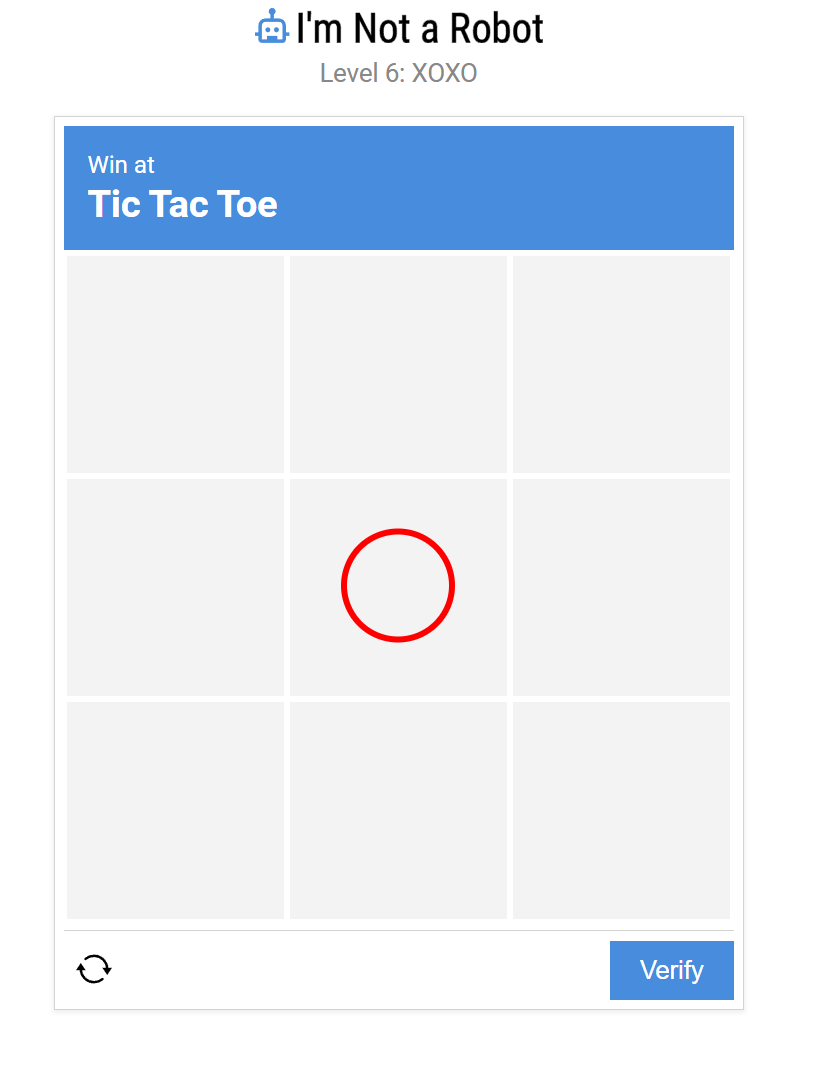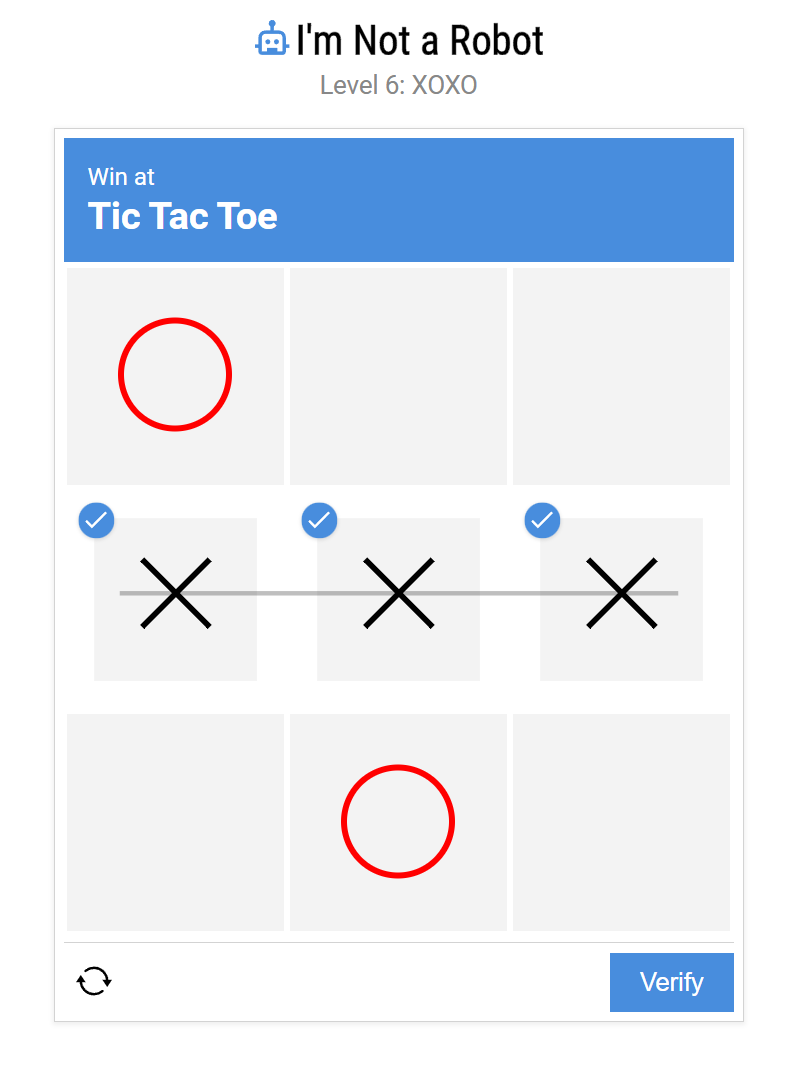How to Beat Level 6 in I'm Not a Robot - Tic Tac Toe Guide
TL;DR
- Objective: Defeat the AI opponent in Level 6 of Neal.Fun's 'I'm Not a Robot' Tic Tac Toe challenge.
- Steps: Use strategic opening moves, create fork opportunities, and force the AI into defensive positions.
- Verification: Win the game to advance to the next level or receive success confirmation.
- Risk: Losing or drawing against the AI will result in challenge failure, requiring game restart.
This guide provides a comprehensive strategy for conquering Level 6 of Neal.Fun's 'I'm Not a Robot' game, specifically the Tic Tac Toe challenge against an AI opponent. Players often struggle with this level due to the AI's strategic capabilities and the need for advanced gameplay tactics. This article presents proven winning strategies and tactical approaches to consistently defeat the computer opponent.
Unlocking Level 6: The 'I'm Not a Robot' Tic Tac Toe Challenge Explained
Level 6 of Neal.Fun's 'I'm Not a Robot' game introduces a strategic Tic Tac Toe battle against an intelligent AI opponent. Unlike simple pattern recognition tasks, this challenge tests players' strategic thinking, tactical planning, and ability to anticipate opponent moves. The AI opponent employs sophisticated strategies, making random or casual play insufficient for victory. Success requires understanding fundamental Tic Tac Toe theory and implementing advanced tactical concepts.

Level 6 Tic Tac Toe Game
Mastering Tic Tac Toe Strategy: A Step-by-Step Guide to Level 6
The key to successfully defeating the AI in Level 6 lies in understanding strategic positioning, creating multiple threats, and forcing the opponent into disadvantageous positions. The game follows standard Tic Tac Toe rules with you playing as O (circles) against the computer's X (crosses). Follow these strategic approaches to achieve consistent victory:
Step 1: Optimal Opening Strategy
- Objective: Secure the strongest possible starting position to maximize winning potential.
- Procedure: If you move first, immediately claim the center square as it participates in four potential winning lines (horizontal, vertical, and both diagonals). If the AI moves first and takes the center, respond by claiming any corner square. Corner squares participate in three potential winning lines and offer the best counter-positioning against center control.
Step 2: Create Fork Opportunities
- Objective: Establish multiple simultaneous winning threats that the opponent cannot block.
- Procedure: A fork occurs when you create two different ways to win on your next move. The most effective fork strategy involves controlling opposite corners, which creates multiple diagonal and edge-based winning opportunities. When you control two opposite corners, the AI cannot simultaneously block all potential winning combinations, guaranteeing your victory.
Step 3: Force Defensive Responses
- Objective: Maintain offensive pressure while preventing AI counterattacks.
- Procedure: After establishing your initial position, focus on creating immediate winning threats that force the AI to respond defensively. Each defensive move the AI makes reduces its offensive options and increases your strategic advantage. Continuously create new threats while maintaining awareness of AI winning opportunities that require blocking.

Level 6 Winning Position
Verification: Confirming Victory
- Objective: Achieve three O symbols in a row to win the challenge.
- Procedure: Victory occurs when you successfully align three O symbols horizontally, vertically, or diagonally. The game will immediately recognize your win and advance to the next level or display success confirmation. If the game ends in a draw or AI victory, you must restart and apply more aggressive strategic approaches.
Common Mistakes and Troubleshooting
- Passive play: Focusing only on blocking AI moves without creating your own threats leads to draws or losses. Always maintain offensive pressure.
- Edge square openings: Starting with edge squares (non-corner, non-center) provides fewer strategic options and reduces winning probability.
- Ignoring fork opportunities: Failing to recognize and create fork situations eliminates your most powerful winning strategy.
Behind the Challenge: Decoding Neal.Fun's AI Opponent Behavior
Neal.Fun's 'I'm Not a Robot' Tic Tac Toe AI employs sophisticated decision-making algorithms that prioritize center control, threat recognition, and defensive positioning. The AI demonstrates near-optimal play in most situations, making it a formidable opponent that requires genuine strategic thinking to defeat. Understanding the AI's behavioral patterns provides crucial advantages in developing winning strategies.
The AI typically prioritizes immediate threat blocking over long-term strategic positioning, creating opportunities for players who can establish multiple simultaneous threats. This behavioral pattern reflects the challenge's design philosophy: rewarding strategic human thinking over simple pattern matching or random play. The AI serves as a benchmark for demonstrating genuine human cognitive abilities.
Pro Tips for Conquering 'I'm Not a Robot' Strategic Challenges
Defeating AI opponents in strategic games requires specific approaches that leverage human cognitive advantages. Beyond the specific Level 6 solution, certain strategic principles can significantly improve your success rate across similar challenges.
Tip 1: Control Key Strategic Positions
- Objective: Prioritize squares that participate in multiple winning combinations.
- Details: Center square participates in four winning lines, corners participate in three, and edges participate in only two. Always prioritize center and corner control over edge positions. This mathematical advantage provides more strategic options and increases winning probability significantly.
Tip 2: Think Multiple Moves Ahead
- Objective: Plan sequences of moves rather than individual responses.
- Details: Successful Tic Tac Toe strategy requires anticipating opponent responses and planning 2-3 moves in advance. Before making any move, visualize the likely AI response and your subsequent options. This forward-thinking approach enables you to set up winning combinations that the AI cannot prevent.
Tip 3: Exploit AI Defensive Patterns
- Objective: Use the AI's defensive priorities to create strategic advantages.
- Details: The AI prioritizes immediate threat blocking, which can be exploited by creating multiple threats in sequence. When you force the AI to respond defensively, you maintain initiative and control the game's direction. Use this pattern to guide the AI into positions that favor your strategic goals.
Tip 4: Utilize the Reset Option Strategically
- Objective: Restart games when initial positioning becomes unfavorable.
- Details: If the AI gains significant early advantage or you make strategic errors, don't hesitate to reset the game. Starting fresh with optimal strategy is often more efficient than attempting to recover from poor positioning. This is particularly useful when the AI achieves strong center control with supporting corner positions.
Frequently Asked Questions About 'I'm Not a Robot' Tic Tac Toe Strategy
Players often have similar questions when tackling Neal.Fun's 'I'm Not a Robot' strategic challenges. Here are answers to some frequently asked queries:
-
Q1: Why do I keep losing even when I think I'm playing well?
-
A1: The AI employs near-optimal strategy, making casual play insufficient. You must actively create fork opportunities and maintain offensive pressure throughout the game. Defensive play alone will not lead to victory against this AI opponent.
-
Q2: Is it possible to always win against the AI?
-
A2: With perfect play, Tic Tac Toe should always end in a draw between optimal players. However, the AI has exploitable patterns that allow consistent human victory when proper strategies are employed, particularly fork creation and strategic positioning.
-
Q3: What's the best opening move if I go first?
-
A3: Center square is mathematically optimal as it participates in the most winning combinations. If the AI takes center first, respond with any corner square to maintain competitive positioning and create fork opportunities.
-
Q4: How do I create effective forks against the AI?
-
A4: The most reliable fork involves controlling opposite corners, which creates multiple winning threats the AI cannot simultaneously block. Focus on establishing this pattern while preventing AI from achieving similar positioning.
-
Q5: Should I always try to block AI winning moves?
-
A5: Yes, blocking immediate AI wins is essential, but don't play purely defensively. After blocking, immediately create your own threats to maintain offensive pressure and strategic initiative.
Final Summary
Successfully conquering Level 6 of 'I'm Not a Robot' requires mastering fundamental Tic Tac Toe strategy and implementing advanced tactical concepts against an intelligent AI opponent. Victory depends on strategic positioning, fork creation, and maintaining offensive pressure throughout the game. To prepare for similar strategic challenges, always prioritize key positions, think multiple moves ahead, and remember that consistent offensive pressure is more effective than purely defensive play.